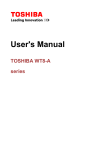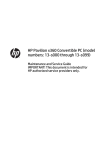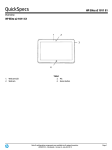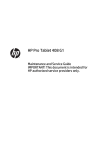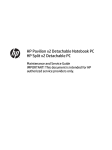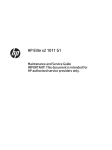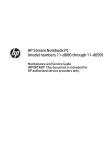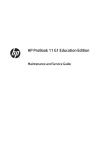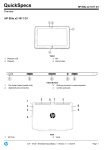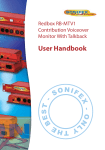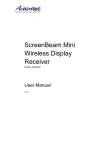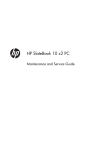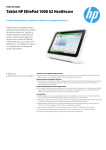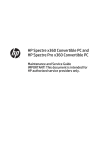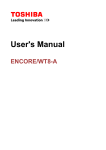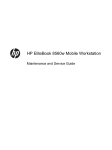Download "user manual"
Transcript
HP ElitePad 1000 G2 Healthcare Tablet Maintenance and Service Guide for Thin Client systems IMPORTANT! This document is intended for HP Qualified service channel partners only. © Copyright 2015 Hewlett-Packard Development Company, L.P. Bluetooth is a trademark owned by its proprietor and used by Hewlett-Packard Company under license. Java is a registered trademark of Oracle and/or its affiliates. microSD is a trademark or registered trademark of SD-3C in the United States, other countries or both. Intel is a U.S. registered trademark of Intel Corporation. Microsoft and Windows are U.S. registered trademarks of Microsoft Corporation. SD Logo is a trademark of its proprietor. The information contained herein is subject to change without notice. The only warranties for HP products and services are set forth in the express warranty statements accompanying such products and services. Nothing herein should be construed as constituting an additional warranty. HP shall not be liable for technical or editorial errors or omissions contained herein. First Edition: May 2015 Document Part Number: 818239-001 Product notice This guide describes features that are common to most models. Some features may not be available on your computer. Not all features are available in all editions of Windows 8. This computer may require upgraded and/or separately purchased hardware, drivers, and/or software to take full advantage of Windows 8 functionality. See for http://www.microsoft.com details. Software terms By installing, copying, downloading, or otherwise using any software product preinstalled on this computer, you agree to be bound by the terms of the HP End User License Agreement (EULA). If you do not accept these license terms, your sole remedy is to return the entire unused product (hardware and software) within 14 days for a refund subject to the refund policy of your place of purchase. For any further information or to request a full refund of the computer, please contact your local point of sale (the seller). Safety warning notice WARNING! To reduce the possibility of heat-related injuries or of overheating the device, do not place the device directly on your lap or obstruct the device air vents. Use the device only on a hard, flat surface. Do not allow another hard surface, such as an adjoining optional printer, or a soft surface, such as pillows or rugs or clothing, to block airflow. Also, do not allow the AC adapter to contact the skin or a soft surface, such as pillows or rugs or clothing, during operation. The device and the AC adapter comply with the user-accessible surface temperature limits defined by the International Standard for Safety of Information Technology Equipment (IEC 60950). iii iv Safety warning notice Table of contents 1 Product description ....................................................................................................................................... 1 2 External component identification ................................................................................................................. 3 Front ....................................................................................................................................................................... 3 Back ........................................................................................................................................................................ 4 Top ......................................................................................................................................................................... 5 Bottom ................................................................................................................................................................... 6 Labels ..................................................................................................................................................................... 6 Changing your tablet's settings ............................................................................................................................. 7 Opening the Control Panel .................................................................................................................. 7 Changing the Control Panel view ........................................................................................................ 7 Changing your tablet's view ................................................................................................................ 7 Using the tablet's autorotate lock feature ....................................................................... 8 Adjusting your tablet's screen brightness ........................................................................ 8 Finding your hardware and software information ................................................................................................ 8 Locating hardware ............................................................................................................................... 8 Locating software ............................................................................................................................... 8 Updating the software installed on the tablet ................................................................................... 9 3 Illustrated parts catalog .............................................................................................................................. 10 Tablet major components ................................................................................................................................... 10 Power components .............................................................................................................................................. 12 Miscellaneous parts ............................................................................................................................................. 13 Jacket major components ................................................................................................................................... 14 Jacket cable kit .................................................................................................................................................... 15 4 Removal and replacement preliminary requirements ..................................................................................... 16 Tools required ...................................................................................................................................................... 16 Service considerations ........................................................................................................................................ 16 Plastic parts ....................................................................................................................................... 16 Cables and connectors ...................................................................................................................... 16 Grounding guidelines ........................................................................................................................................... 16 Electrostatic discharge damage ....................................................................................................... 16 Packaging and transporting guidelines ......................................................................... 18 Workstation guidelines ................................................................................ 18 v 5 Removal and replacement procedures for Authorized Service Provider parts ................................................... 20 Jacket component replacement procedures ...................................................................................................... 20 Attaching the hand strap .................................................................................................................. 21 Bottom I/O door—IP-54 rating ......................................................................................................... 22 Smart card ......................................................................................................................................... 23 Connecting a stylus ........................................................................................................................... 24 Jacket, removing from tablet ........................................................................................................... 26 I/O access cover ................................................................................................................................. 28 Back plate .......................................................................................................................................... 29 Back plate components ..................................................................................................................... 30 Card reader cover .............................................................................................................................. 31 Bar code scanner ............................................................................................................................... 32 Scanner button boards (2) ................................................................................................................ 33 70-pin connector ............................................................................................................................... 35 I/O board ............................................................................................................................................ 36 Tablet component replacement procedures ...................................................................................................... 38 Micro SIM or microSD card ................................................................................................................. 38 Display assembly .............................................................................................................................. 40 WWAN module ................................................................................................................................... 46 WLAN module .................................................................................................................................... 48 Microphones ...................................................................................................................................... 50 Rear-facing webcam ......................................................................................................................... 51 Power button board .......................................................................................................................... 52 Volume button board ........................................................................................................................ 54 Audio jack board ................................................................................................................................ 56 TXE board .......................................................................................................................................... 57 Vibrator module ................................................................................................................................ 58 Battery ............................................................................................................................................... 59 System board .................................................................................................................................... 60 Forward-facing webcam ................................................................................................................... 64 Slot cover ........................................................................................................................................... 65 Docking connector cable ................................................................................................................... 66 WLAN antenna ................................................................................................................................... 68 WWAN/GPS auxiliary antenna ........................................................................................................... 70 Speakers ............................................................................................................................................ 71 6 HP PC Hardware Diagnostics (UEFI) ............................................................................................................... 73 Using HP PC Hardware Diagnostics (UEFI) .......................................................................................................... 73 Downloading HP PC Hardware Diagnostics (UEFI) to a USB device .................................................................... 73 vi 7 Specifications ............................................................................................................................................. 75 Tablet specifications ........................................................................................................................................... 75 8 Statement of Volatility ................................................................................................................................ 76 Non-volatile memory usage ................................................................................................................................ 77 Questions and answers ....................................................................................................................................... 80 9 Power cord set requirements ........................................................................................................................ 81 Requirements for all countries ........................................................................................................................... 81 Requirements for specific countries and regions ............................................................................................... 81 10 Recycling .................................................................................................................................................. 83 Index ............................................................................................................................................................. 84 vii viii 1 Product description Category Description Product Name HP ElitePad 1000 G2 Healthcare Tablet Processor Intel® Atom z3795 1.60-GHz processor (core burst up to 2.39-GHz), 1.60-GHz front-side bus (FSB), 2.0-MB L2 cache, up to 778-MHz graphics burst frequency, soldered to system board Graphics Intel HD Graphics Panel 10.1-in., WUXGA (1900×1200), UWVA, 50% CG, 400-nit, active pen and MultiTouch capacitive digitizer, chemically-strengthened glass with anti-smudge Memory On-board 1067-MHz, LPDDR3, 4096-MB memory (soldered to system board); system supports a 4096-MB × 1 (4 pieces, 128 MB × 32 chips) configuration Primary storage 64-GB embedded MultiMedia Card (eMMC), soldered to the system board Optical drive No internal optical drive or USB-powered optical drive is supported Audio and video 2 integrated stereo speakers, each 1.5 W HD Audio SRS Audio Digital microphone 2 fixed, integrated webcams (1080p, 2.1-MP front-facing webcam; 8.0-MP rear-facing webcam with LED flash) Ethernet No direct Ethernet support Wireless Integrated wireless local area network (WLAN) options by way of wireless module (select models only) Integrated WLAN antennas Support for the Broadcom BCM43241 802.11abgn 2x2 Wi-Fi + BT 4.0 Combo Adapter Ports Audio-in (mono microphone)/audio-out (stereo headphone) combo jack HP ElitePad 900-proprietary docking connector On-board digital dual array microphones HDMI port USB 3.0 port Sensors Accelerometer + eCompass Ambient light sensor Gyroscope Haptics Docking HP ElitePad-G1 Docking Station with 4 standard 3.0 USB ports, VGA port, HDMI-out port, audio in/ out jacks, RJ-45 jack, and HP Smart AC adapter connector Keyboard/pointing devices No integrated keyboard or TouchPad Support for USB- or Bluetooth-connected external keyboard and mouse 1 Category Description Power requirements Support for an HP ElitePad-proprietary 10-W AC adapter (3-wire, wall-mount and 2-wire, wallmount for use in Japan); connector on AC Adapter connects to the tablet through the docking connector Support for 2-cell, 30-Wh, 4.0-Ah, Li-ion battery Security Support for trusted platform module (TPM; Infineon TPM is SLB9656VQ1.2FW4.32) Operating system Preinstalled: Microsoft® Windows® Embedded 8.1 Industry 64 Professional 2 Chapter 1 Product description 2 External component identification Front Component Description (1) WWAN antennas (2)* (select models only) Send and receive wireless signals to communicate with wireless wide area networks (WWAN). (2) Front webcam Records video and captures still photographs. To use the webcam, swipe from the right edge of the touch screen to display the charms, tap the Search icon, and then tap the search box. In the search box, type c, and then tap Camera. (3) WLAN antennas (2)* Send and receive wireless signals to communicate with wireless local area networks (WLAN). (4) Ambient light sensor The ambient light sensor automatically adjusts the display brightness based on the lighting conditions in your environment. (5) Webcam status light (front) On: The webcam is on. (6) Near Field Communications (NFC) tapping area (select models only) Allows you to touch an NFC-compatible device to this area to wirelessly connect and communicate with the tablet and transfer data back and forth. (7) Windows button Displays the Start screen. *The antennas are not visible from the outside of the tablet. For optimal transmission, keep the areas immediately around the antennas free from obstructions. For wireless regulatory notices, see the section of the Regulatory, Safety, and Environmental Notices that applies to your country or region. To access this guide, from the Start screen, select the Hewlett-Packard app, and then select HP Documentation. Front 3 Back Component Description (1) Hand strap connectors (4) Attach the hand strap on the right or left side. (2) Smart card reader Supports optional smart cards. (3) Smart card reader light On: A smart card is fully inserted. (4) Bar-code scanner buttons (select models only) Press to use the bar-code scanner. (5) Webcam light On: The webcam is in use. (6) Webcam Records video and captures photographs. You can video conference and chat online using streaming video. (7) Volume buttons (2) Control the volume. (8) Security cable slot Attaches an optional security cable to the tablet. NOTE: The security cable is designed to act as a deterrent, but it may not prevent the tablet from being mishandled or stolen. 4 Chapter 2 External component identification Top Component (1) Description Audio-out (headphone)/Audio-in (microphone) combo jack Connects optional powered stereo speakers, headphones, earbuds, a headset, or a display audio cable. Also connects an optional headset microphone. This jack does not support optional microphone-only devices. WARNING! To reduce the risk of personal injury, adjust the volume before putting on headphones, earbuds, or a headset. For additional safety information, see the Regulatory, Safety, and Environmental Notices. To access this guide, from the Start screen, select the HewlettPackard app, and then select HP Documentation. NOTE: When a device is connected to the jack, the tablet speakers are disabled. NOTE: Be sure that the device cable has a 4-conductor connector that supports both audio-out (headphone) and audio-in (microphone). (2) Stylus connector Attaches a stylus using a lanyard. (3) Internal microphones (2) Record sound. (4) Power button ● When the tablet is off, press the button to turn on the tablet. ● When the tablet is on, press the button briefly to initiate Sleep. ● When the tablet is in the Sleep state, press the button briefly to exit Sleep. CAUTION: Pressing and holding down the power button results in the loss of unsaved information. If the tablet has stopped responding and Windows® shutdown procedures are ineffective, press and hold the power button for at least 5 seconds to turn off the tablet. To learn more about your power settings, see your power options. From the Start screen, type power, select Power and sleep settings, and then select Power and sleep from the list of applications. Top 5 Bottom NOTE: To access the bottom components, lift the I/O door using both thumbs. To close the I/O door, push it in and then press down until it is firmly seated. Component Description (1) Speakers (2) Produce sound. (2) Shoulder strap connector Connects an optional shoulder strap. (3) HDMI port Connects an optional video or audio device, such as a highdefinition display, any compatible digital or audio component, or a high-speed HDMI device. (4) Power connector/Docking connector Connects an AC adapter or an optional docking device. (5) USB 3.0 port Connects an optional USB device, such as a keyboard, mouse, external drive, printer, scanner or USB hub. (6) Bar-code scanner (select models only) Scans bar codes. Labels The labels affixed to the tablet provide information you may need when you troubleshoot system problems or travel internationally with the tablet. IMPORTANT: Check the following location for the labels described in this section: on the back of the tablet. ● Service label—Provides important information to identify your tablet. When contacting support, you will probably be asked for the serial number, and possibly for the product number or the model number. Locate these numbers before you contact support. ● Microsoft® Certificate of Authenticity label (select models only prior to Windows 8)—Contains the Windows Product Key. You may need the Product Key to update or troubleshoot the operating system. HP platforms with Windows 8 or Windows 8.x preinstalled do not have the physical label. Instead a Digital Product Key is electronically installed. NOTE: The Digital Product Key is automatically recognized and activated by Microsoft operating systems when a Windows 8 or Windows 8.x operating system is reinstalled using HP-approved recovery methods. 6 ● Regulatory label(s)—Provide(s) regulatory information about the tablet. ● Wireless certification label(s)—Provide(s) information about optional wireless devices and the approval markings for the countries or regions in which the devices have been approved for use. Chapter 2 External component identification ● Laser label(s) (select models only)—Provide information about using the bar-code scanner laser properly. Changing your tablet's settings Opening the Control Panel You can open the Control Panel using any of the following methods: ▲ Right-click the Windows icon on the taskbar and select Control Panel from the menu. TIP: A right-click can also be performed by touching and holding the desired location on the touch screen. ▲ Open the Charms bar and select Settings > Control Panel. ▲ On the Start screen, type Control Panel, and then click Control Panel when it appears in the search results. Changing the Control Panel view The default Control Panel view is by Large icons. You may prefer to change the view to Category mode. To change the Control Panel view: 1. Click the Start button, and then select Control Panel. 2. In the View by menu, select Category. 3. To return to viewing by large icons, in the View by menu, select Large icons. Changing your tablet's view Your tablet's orientation, or view, changes automatically from landscape to portrait view, or from portrait to landscape view. Changing your tablet's settings 7 1. To change the view of your tablet from landscape view to portrait view: Hold the tablet vertically, and then turn it 90 degrees to the right (in a clockwise direction). 2. To change the view of your tablet from portrait view to landscape view: Hold the tablet vertically, and then turn it 90 degrees to the left (in a counter-clockwise direction). Using the tablet's autorotate lock feature To turn on your tablet's autorotate lock feature: 1. Swipe from the right edge of the touch screen to display the charms, and then tap Settings. 2. Tap the screen icon to lock your current tablet screen in place and to prevent rotation. The icon displays a lock symbol when the autorotate lock is active. To turn off your tablet's autorotate lock feature: 1. Swipe from the right edge of the touch screen to display the charms, and then tap Settings. 2. Tap the Screen icon at the bottom right, and then tap the autorotate lock icon again. Adjusting your tablet's screen brightness To adjust the screen brightness: 1. Swipe from the right edge of the touch screen to display the charms, and then tap Settings. 2. Tap the Screen icon at the bottom right. A vertical slider displays that controls the screen brightness. NOTE: On the Windows desktop, you can also tap the Power Meter icon in the notification area at the far right of the taskbar, tap Adjust screen brightness, and then move the slider next to Screen brightness at the bottom of the screen. Finding your hardware and software information Locating hardware You can use Windows Device Manager to find out what hardware is installed on your tablet. To use Device Manager, you must be logged in as an Administrator. To open Device Manager: 1. Open the Control Panel, and then tap Device Manager. 2. To access Device Manager for the first time, select Update device drivers to open the Device Manager window. To access Device Manager in subsequent searches, select Device Manager. A list displays all the devices installed on your tablet. Locating software ▲ 8 To find out what software is installed on your tablet, on the Start screen, swipe up from the center of the touch screen to display the Apps screen. Chapter 2 External component identification Updating the software installed on the tablet Most software, including the operating system, is updated frequently by the manufacturer or provider. Important updates to the software included with the tablet may have been released since the tablet left the factory. Some updates may affect the way the tablet responds to optional software or external devices. Many updates provide security enhancements. Update the operating system and other software installed on the tablet as soon as the tablet is connected to the Internet. Access the updates on the HP website at http://www.hp.com. Finding your hardware and software information 9 3 Illustrated parts catalog NOTE: HP continually improves and changes product parts. For complete and current information on supported parts for your computer, go to http://partsurfer.hp.com, select your country or region, and then follow the on-screen instructions. Tablet major components 10 Chapter 3 Illustrated parts catalog Item Component Spare part number (1) Display assembly (10.1-in., WUXGA (1900×1200), UWVA, 50% CG, 400-nit, active pen and MultiTouch capacitive digitizer, chemically-strengthened glass with anti-smudge; includes display panel, display LVDS cable, TouchScreen cable, and display panel support rubber) 747658-001 Display Cable Kit, includes: 747625-001 (2a) TouchScreen cable (2b) Display LVDS cable Button Kit, includes: (3a) Power button actuator (3b) Volume button actuator (3c) Autorotate switch actuator (3d) Slot cover hardware (slot cover, retention bracket, spring bracket) (3e) Docking connector bracket 747634-001 Webcam/Microphone Kit, includes: (4a) Left microphone (4b) Right microphone (5a) Rear-facing webcam (5b) Front-facing webcam (6) Power button board (includes cable) 762828-001 For use only on models equipped with the Windows Embedded 8.1 Industry 64 Professional operating system 809878-901 For use only on models without an operating system 753976-001 (7) Volume button board (includes bracket and cable) 759031-001 (8) WWAN module (HP lt4226 LTE/HSPA+ Gobi 4G Module) 736675-005 (9) 2-cell, 30-Wh, 4.0-Ah, Li-ion battery (includes battery cable) 728558-005 (10) System board equipped with an Intel Atom z3795 quad core 1.60-GHz processor (burst up to 2.39-GHz; 2.0-MB L2 cache), 4096-MB of system memory, and 64-GB of eMMC primary storage (includes processor, memory, and eMMC) 753740-001 (11) Audio jack board (includes audio jack and cable) 747627-001 Antenna Kit for use in Japan, includes: 767885-001 (12) WWAN/GPS auxiliary antenna cable and transceiver (13) WLAN main and auxiliary antenna cables and transceivers Antenna Kit for use in European countries and regions, North America, and Latin America 799297-001 (13) WLAN main and auxiliary antenna cables and transceivers (14) Broadcom BCM43241 802.11abgn 2x2 Wi-Fi + BT 4.0 Combo Adapter 723677-005 (15) Vibrator module (includes cable, double-sided adhesive, plastic cover) 747630-001 (16) Docking connector cable (includes cable and double-sided adhesive) 747631-001 Tablet major components 11 Item Component Spare part number (17) Speakers (include left and right speakers and cables) 747629-001 (18) TXE board 753977-001 (19) Bottom case (includes the power button actuator and the slot cover and brackets) 747628-001 Power components Item Component (1) AC adapter (2) (3) 12 Spare part number 10W, RC, V, 3-wire, wall mount 686120-001 10W, Non-PFC, non-Smart adapter, 2-wire, wall-mount (for use in Japan) 746156-001 40-W Smart AC adapter (RC, V, 3-wire) 693717-001 Duck head power adapter: For use in Australia 755184-011 For use in Denmark 755184-081 For use in Europe 755184-021 For use in India 755184-D61 For use in Israel 755184-BB1 For use in Italy 755184-061 For use in Japan 720949-291 For use in the People's Republic of China 755184-371 For use in South Africa 755184-AR1 For use in Switzerland 755184-BG1 For use in the United Kingdom and Singapore 755184-031 For use in the United States 755184-001 Power cord: For use in Australia 490371-011 For use in the People’s Republic of China 490371-AA1 For use in Europe, the Middle East, and Africa 490371-011 Chapter 3 Illustrated parts catalog Item Component Spare part number For use in India 490371-D61 For use in Israel 490371-BB1 For use in Italy 490371-061 For use in Japan 490371-291 For use in South Africa 490371-AR1 For use in South Korea 490371-AD1 For use in Taiwan 490371-AB1 For use in Switzerland 490371-111 For use in the United Kingdom 490371-031 For use in the United States 490371-001 Miscellaneous parts Component Spare part number HP ElitePad Service Tool (includes suction cup) 714222-001 HP ElitePad suction cup 714223-001 Screw Kit 753735-001 Card Reader Cover Kit (not illustrated) 747632-001 Docking station 708621-001 Tape Support Kit 762827-001 Miscellaneous parts 13 Jacket major components 14 Item Component Spare part number (1) Bezel Kit 791204-001 (2) Back plate (includes card reader and LED board 791201-001 (3) Scanner button board 791208-001 (4) 70-pin connector 791199-001 (5) I/O board Includes 70-pin connector 791209-001 Does not include 70-pin connector 791210-001 (6) Bar code scanner 791207-001 (7) Rear cover Does not include card reader cover 791205-001 Includes card reader cover 799306-001 Does not include bar code reader cover 799307-001 Includes bar code reader cover 799308-001 (8) I/O access cover 791200-001 (9) Pen holder 791214-001 (10) Card reader cover 791203-001 Chapter 3 Illustrated parts catalog Item Component Spare part number (11) QR plug kit 791215-001 (12) QR pin kit 791212-001 (13) Handle/headphone kit 791213-001 Shoulder strap (not illustrated) 809063-001 Hinge kit (not illustrated) 791206-001 Screw kit (not illustrated) 791211-001 Jacket cable kit Item Component Spare part number Jacket cable kit 791202-001 (1) LED cable (2) Button board cable (right) (3) Button board cable (left) (4) Scanner cable Jacket cable kit 15 4 Removal and replacement preliminary requirements Tools required You will need the following tools to complete the removal and replacement procedures: ● Magnetic screw driver ● Phillips P0 screw driver ● Plastic case utility tool Service considerations The following sections include some of the considerations that you must keep in mind during disassembly and assembly procedures. NOTE: As you remove each subassembly from the tablet, place the subassembly (and all accompanying screws) away from the work area to prevent damage. Plastic parts CAUTION: Using excessive force during disassembly and reassembly can damage plastic parts. Use care when handling the plastic parts. Apply pressure only at the points designated in the maintenance instructions. Cables and connectors CAUTION: When servicing the tablet, be sure that cables are placed in their proper locations during the reassembly process. Improper cable placement can damage the tablet. Cables must be handled with extreme care to avoid damage. Apply only the tension required to unseat or seat the cables during removal and insertion. Handle cables by the connector whenever possible. In all cases, avoid bending, twisting, or tearing cables. Be sure that cables are routed in such a way that they cannot be caught or snagged by parts being removed or replaced. Handle flex cables with extreme care; these cables tear easily. Grounding guidelines Electrostatic discharge damage Electronic components are sensitive to electrostatic discharge (ESD). Circuitry design and structure determine the degree of sensitivity. Networks built into many integrated circuits provide some protection, but in many cases, ESD contains enough power to alter device parameters or melt silicon junctions. A discharge of static electricity from a finger or other conductor can destroy static-sensitive devices or microcircuitry. Even if the spark is neither felt nor heard, damage may have occurred. 16 Chapter 4 Removal and replacement preliminary requirements An electronic device exposed to ESD may not be affected at all and can work perfectly throughout a normal cycle. Or the device may function normally for a while, then degrade in the internal layers, reducing its life expectancy. CAUTION: To prevent damage to the tablet when you are removing or installing internal components, observe these precautions: Keep components in their electrostatic-safe containers until you are ready to install them. Before touching an electronic component, discharge static electricity by using the guidelines described in this section. Avoid touching pins, leads, and circuitry. Handle electronic components as little as possible. If you remove a component, place it in an electrostatic-safe container. The following table shows how humidity affects the electrostatic voltage levels generated by different activities. CAUTION: A product can be degraded by as little as 700 V. Typical electrostatic voltage levels Relative humidity Event 10% 40% 55% Walking across carpet 35,000 V 15,000 V 7,500 V Walking across vinyl floor 12,000 V 5,000 V 3,000 V Motions of bench worker 6,000 V 800 V 400 V Removing DIPS from plastic tube 2,000 V 700 V 400 V Removing DIPS from vinyl tray 11,500 V 4,000 V 2,000 V Removing DIPS from Styrofoam 14,500 V 5,000 V 3,500 V Removing bubble pack from PCB 26,500 V 20,000 V 7,000 V Packing PCBs in foam-lined box 21,000 V 11,000 V 5,000 V Grounding guidelines 17 Packaging and transporting guidelines Follow these grounding guidelines when packaging and transporting equipment: ● To avoid hand contact, transport products in static-safe tubes, bags, or boxes. ● Protect ESD-sensitive parts and assemblies with conductive or approved containers or packaging. ● Keep ESD-sensitive parts in their containers until the parts arrive at static-free workstations. ● Place items on a grounded surface before removing items from their containers. ● Always be properly grounded when touching a component or assembly. ● Store reusable ESD-sensitive parts from assemblies in protective packaging or nonconductive foam. ● Use transporters and conveyors made of antistatic belts and roller bushings. Be sure that mechanized equipment used for moving materials is wired to ground and that proper materials are selected to avoid static charging. When grounding is not possible, use an ionizer to dissipate electric charges. Workstation guidelines Follow these grounding workstation guidelines: 18 ● Cover the workstation with approved static-shielding material. ● Use a wrist strap connected to a properly grounded work surface and use properly grounded tools and equipment. ● Use conductive field service tools, such as cutters, screw drivers, and vacuums. ● When fixtures must directly contact dissipative surfaces, use fixtures made only of staticsafe materials. ● Keep the work area free of nonconductive materials, such as ordinary plastic assembly aids and Styrofoam. ● Handle ESD-sensitive components, parts, and assemblies by the case or PCM laminate. Handle these items only at static-free workstations. ● Avoid contact with pins, leads, or circuitry. ● Turn off power and input signals before inserting or removing connectors or test equipment. Chapter 4 Removal and replacement preliminary requirements Equipment guidelines Grounding equipment must include either a wrist strap or a foot strap at a grounded workstation. ● When seated, wear a wrist strap connected to a grounded system. Wrist straps are flexible straps with a minimum of one megohm ±10% resistance in the ground cords. To provide proper ground, wear a strap snugly against the skin at all times. On grounded mats with banana-plug connectors, use alligator clips to connect a wrist strap. ● When standing, use foot straps and a grounded floor mat. Foot straps (heel, toe, or boot straps) can be used at standing workstations and are compatible with most types of shoes or boots. On conductive floors or dissipative floor mats, use foot straps on both feet with a minimum of one megohm resistance between the operator and ground. To be effective, the conductive must be worn in contact with the skin. The following grounding equipment is recommended to prevent electrostatic damage: ● Antistatic tape ● Antistatic smocks, aprons, and sleeve protectors ● Conductive bins and other assembly or soldering aids ● Nonconductive foam ● Conductive tabletop workstations with ground cords of one megohm resistance ● Static-dissipative tables or floor mats with hard ties to the ground ● Field service kits ● Static awareness labels ● Material-handling packages ● Nonconductive plastic bags, tubes, or boxes ● Metal tote boxes ● Electrostatic voltage levels and protective materials The following table lists the shielding protection provided by antistatic bags and floor mats. Material Use Voltage protection level Antistatic plastics Bags 1,500 V Carbon-loaded plastic Floor mats 7,500 V Metallized laminate Floor mats 5,000 V Grounding guidelines 19 5 Removal and replacement procedures for Authorized Service Provider parts CAUTION: Components described in this chapter should only be accessed by an authorized service provider. Accessing these parts can damage the computer or void the warranty. NOTE: HP continually improves and changes product parts. For complete and current information on supported parts for your computer, go to http://partsurfer.hp.com, select your country or region, and then follow the on-screen instructions. Jacket component replacement procedures This chapter provides removal and replacement procedures for Authorized Service Provider only parts. There are as many as 35 screws that must be removed, replaced, and/or loosened when servicing the jacket. Make special note of each screw size and location during removal and replacement. 20 Chapter 5 Removal and replacement procedures for Authorized Service Provider parts Attaching the hand strap Attach one of the two provided hand straps to either the left or the right side of the tablet. Retain the second hand strap and use it to replace the first hand strap when it needs to be cleaned. To attach the hand strap: 1. Position the hand strap over either the right or left hand strap connectors on the back of the tablet. 2. Position the quick-release fasteners over the holes in the hand strap, and then connect the quickrelease fasteners to secure the hand strap. To remove the hand strap: 1. Press the center of the quick-release fastener and then lift it to remove it from the tablet. Repeat for the second quick-release fastener. 2. Remove the hand strap from the tablet. Jacket component replacement procedures 21 Bottom I/O door—IP-54 rating This tablet is rated IP-54, which means that it is protected against dust and splashing water. To maintain the IP-54 rating, close the audio-in (headphone)/audio-out (microphone) jack and all I/O doors. To close the bottom I/O door: 22 1. Insert the bottom edge of the I/O door beneath the front edge of the tablet (1), and then press the door to close it (2). 2. Press the door on each side as well as the middle to ensure that there is a good seal. Visually confirm that it is fully closed. Chapter 5 Removal and replacement procedures for Authorized Service Provider parts Smart card To insert a smart card: 1. Gently lift the I/O door on the back of the tablet to open it. 2. Hold the card label-side up, and gently slide the card into the smart card reader slot until the card is seated. TIP: When the card is fully seated, the smart card light turns on. 3. Close the I/O door. 4. Follow the on-screen instructions for logging on to the tablet using the smart card PIN. Jacket component replacement procedures 23 Connecting a stylus To connect a stylus to the tablet, follow the stylus manufacturer’s instructions for downloading software and drivers, if necessary. To store the stylus: 1. Connect the included stylus holder to the tablet. NOTE: 2. The stylus holder is not reversible. Verify that you have attached it correctly before continuing. Connect the stylus (not included) to the stylus holder. To store a stylus using a lanyard: 1. 24 Insert the bottom loop of the lanyard through the stylus connector (1). Chapter 5 Removal and replacement procedures for Authorized Service Provider parts 2. Insert the rest of the lanyard through the bottom loop (2), and then pull the lanyard away from the loop to secure it (3). Jacket component replacement procedures 25 Jacket, removing from tablet Description Spare part number Jacket xxxxxx-001 Before removing the jacket, follow these steps: 1. Turn off the tablet. If you are unsure whether the tablet is off or in Hibernation, turn the tablet on, and then shut it down through the operating system. 2. Disconnect the power from the tablet by unplugging the power cord from the tablet. 3. Disconnect all external devices from the tablet. Remove the jacket: 1. 26 Remove the top four Phillips PM2.0×3.2 screws (1), and then remove the eight Phillips PM2.0×3.2 screws from the bottom and sides of the jacket (2). Two of the bottom screws are inside the bottom I/O door. Chapter 5 Removal and replacement procedures for Authorized Service Provider parts 2. Carefully lift the edges of the front cover off the jacket, and then remove the cover. 3. Lift the tablet from the jacket at an angle, and then pull the tablet away from the bottom of the jacket to disconnect the tablet from the connector in the jacket. Reverse this procedure to install the jacket. Jacket component replacement procedures 27 I/O access cover Description Spare part number I/O access cover 791200-001 Before removing the I/O access cover, follow these steps: 1. Turn off the tablet. If you are unsure whether the tablet is off or in Hibernation, turn the tablet on, and then shut it down through the operating system. 2. Disconnect the power from the tablet by unplugging the power cord from the tablet. 3. Disconnect all external devices from the tablet. Remove the I/O access cover: 1. Open the access cover. 2. While grasping the strap near where it enters the tablet, pull on the rubber strap to remove it from tablet. Getting the strap to release may require moving the strap back and forth while pulling it. Reverse this procedure to install the I/O access cover. 28 Chapter 5 Removal and replacement procedures for Authorized Service Provider parts Back plate Description Spare part number Back plate 791201-001 Before removing the back plate, follow these steps: 1. Turn off the tablet. If you are unsure whether the tablet is off or in Hibernation, turn the tablet on, and then shut it down through the operating system. 2. Disconnect the power from the tablet by unplugging the power cord from the tablet. 3. Disconnect all external devices from the tablet. Remove the back plate: 1. Remove the 13 silver Phillips PM2.0×4.5 screws (1) that secure the back plate to the rear cover. 2. Remove 2 small black PM1.0×3.2 screws (2) from holes on both sides of the 70-pin connector. 3. Lift the back plate off the rear cover (3). Reverse this procedure to install the back plate. Jacket component replacement procedures 29 Back plate components Use the following image to identify the components spared on the back plate. (1): Button board (2): Bar code reader (3): 70-pin connector (4): I/O board (5): Button board NOTE: The smart card scanner board, located in the middle of the back plate and not called out in the following image, is spared with the back plate. This board is not spared separately. 30 Chapter 5 Removal and replacement procedures for Authorized Service Provider parts Card reader cover Description Spare part number Card reader cover 791203-001 Before removing the card reader cover, follow these steps: 1. Turn off the tablet. If you are unsure whether the tablet is off or in Hibernation, turn the tablet on, and then shut it down through the operating system. 2. Disconnect the power from the tablet by unplugging the power cord from the tablet. 3. Disconnect all external devices from the tablet. 4. Remove the back plate (see Back plate on page 29). Remove the card reader cover: 1. From the inside of the rear cover, remove the six Phillips PM2.0×4.5 screws (1) that secure the card reader cover. 2. Pull the two 'L' shaped metal pins away from the cover (2). 3. Remove the card reader cover from the rear cover (3). Reverse this procedure to install the card reader cover. Jacket component replacement procedures 31 Bar code scanner Description Spare part number Bar code scanner 791207-001 Before removing the bar code scanner, follow these steps: 1. Turn off the tablet. If you are unsure whether the tablet is off or in Hibernation, turn the tablet on, and then shut it down through the operating system. 2. Disconnect the power from the tablet by unplugging the power cord from the tablet. 3. Disconnect all external devices from the tablet. 4. Remove the back plate (see Back plate on page 29). Remove the bar code scanner: 1. Remove the three Phillips PM2.0×3.2 screws (1) and the two Phillips PM1.0×3.2 screws that secure the bar code scanner to the back plate (2). Note that a cable connects to the bottom of the board. 2. Turn over the board to access the connector underneath (3). 3. Lift the tape from atop the connector (4), and then disconnect the cable from the board (5). Reverse this procedure to install the bar code scanner. 32 Chapter 5 Removal and replacement procedures for Authorized Service Provider parts Scanner button boards (2) Description Spare part number Scanner button boards 791208-001 Use the same procedures to remove either of the two scanner button boards shown by callouts (1) and (5) in the following image. Before removing the scanner button boards, follow these steps: 1. Turn off the tablet. If you are unsure whether the tablet is off or in Hibernation, turn the tablet on, and then shut it down through the operating system. 2. Disconnect the power from the tablet by unplugging the power cord from the tablet. 3. Disconnect all external devices from the tablet. 4. Remove the back plate (see Back plate on page 29). Remove the scanner button boards: 1. Lift the tape from atop the connector on the board (1), and then disconnect the cable (2). 2. Remove the two Phillips PM2.0×2.4 screws (3) that secure the board to the back plate.. Jacket component replacement procedures 33 3. Lift the scanner button board from the back plate (4). Reverse this procedure to install the scanner button boards. 34 Chapter 5 Removal and replacement procedures for Authorized Service Provider parts 70-pin connector Description Spare part number 70-pin connector 791199-001 The 70-pin connector connects to the I/O board. Before removing the 70-pin connector, follow these steps: 1. Turn off the tablet. If you are unsure whether the tablet is off or in Hibernation, turn the tablet on, and then shut it down through the operating system. 2. Disconnect the power from the tablet by unplugging the power cord from the tablet. 3. Disconnect all external devices from the tablet. 4. Remove the back plate (see Back plate on page 29). Remove the 70-pin connector: 1. From the inside of the back plate, remove the two Phillips PM2.0×4.5 screws (1) that secure the connector to the back plate. 2. Pull the connector out through the slot in the back plate, and then pull it back to gain access to the two screws underneath (2). 3. Remove the two Phillips PM2.0×4.5 screws (3). 4. Pull the connector out from the back plate to disconnect the connector from I/O board (4). Reverse this procedure to install the 70-pin connector. Jacket component replacement procedures 35 I/O board Description Spare part number I/O board without 70-pin connector 791210-001 I/O board with 70-pin connector 791209-001 Before removing the I/O board, follow these steps: 1. Turn off the tablet. If you are unsure whether the tablet is off or in Hibernation, turn the tablet on, and then shut it down through the operating system. 2. Disconnect the power from the tablet by unplugging the power cord from the tablet. 3. Disconnect all external devices from the tablet. 4. Remove the back plate (see Back plate on page 29). 5. If installed, remove the 70-pin connector (see 70-pin connector on page 35). Remove the I/O board: 36 1. Remove the three Phillips PM2.0×4.5 screws (1) that secure the I/O board to the back plate. 2. Rotate the board upward to gain access to connectors underneath (2). 3. Disconnect the scanner button board cable (right) (1). 4. Disconnect the LED board cable (2). 5. Disconnect the scanner button board cable (left) (3). Chapter 5 Removal and replacement procedures for Authorized Service Provider parts 6. Disconnect the bar code scanner cable (4). Reverse this procedure to install the I/O board. Jacket component replacement procedures 37 Tablet component replacement procedures This chapter provides removal and replacement procedures for Authorized Service Provider only parts. There are as many as 34 screws that must be removed, replaced, and/or loosened when servicing the tablet. Make special note of each screw size and location during removal and replacement. Micro SIM or microSD card CAUTION: To prevent damage to the connectors, use minimal force when inserting a micro SIM or microSD card. WARNING! HP recommends that an authorized, qualified HP service provider, or participants in the HP SelfMaintainer program perform insertion or removal of a micro SIM or microSD card. Any damage caused by the customer removing the tablet from the jacket is not covered under the limited warranty of the product. HP requires that an authorized, qualified HP service provider, or participants in the HP Self-Maintainer program perform future maintenance operations. Before removing the micro SIM or microSD card, follow these steps: 1. Turn off the tablet. If you are unsure whether the tablet is off or in Hibernation, turn the tablet on, and then shut it down through the operating system. 2. Disconnect the power from the tablet by unplugging the power cord from the tablet. 3. Disconnect all external devices from the tablet. 4. Remove the jacket (see Jacket, removing from tablet on page 26). To insert or remove a micro SIM or microSD card, follow these steps: NOTE: The access door is located on the tablet. 38 1. Insert the end of a paper clip into the access door release hole (1). 2. Press in gently until the access door is released, and then open the access door (2). Chapter 5 Removal and replacement procedures for Authorized Service Provider parts 3. Insert the micro SIM into the micro SIM slot (3) or the microSD card into the microSD card reader. Then, press in to lock it into place. – or – Release the micro SIM or microSD card by pressing on it. Then, remove it. 4. Reseat the access door hinge (1), and then close the access door (2). Reverse this procedure to install the micro SIM or microSD card. Tablet component replacement procedures 39 Display assembly Description Spare part number 10.1-in., WUXGA (1900×1200), UWVA, 50% CG, 400-nit, active pen and MultiTouch capacitive digitizer, chemically-strengthened glass with anti-smudge; includes display panel, display LVDS cable, TouchScreen cable, and display panel support rubber 747658-001 Before disassembling the tablet, follow these steps: 1. Turn off the tablet. If you are unsure whether the tablet is off or in Hibernation, turn the tablet on, and then shut it down through the operating system. 2. Disconnect the power from the tablet by unplugging the power cord from the tablet. 3. Disconnect all external devices from the tablet. Remove the display assembly: 1. Remove the two Phillips PM1.4×3.2 screws that secure the display assembly to the tablet. 2. Place the HP ElitePad Service Tool on a flat, sturdy surface. The HP ElitePad Service Tool is available using spare part number 714222-001. 3. 40 Move the HP ElitePad Service Tool retention bar (1) to the left until the notch (2) in the retention bar allows the retention gate to open. Chapter 5 Removal and replacement procedures for Authorized Service Provider parts 4. Open the retention gate (3). 5. Place the tablet on the service tool and slide it (1) forward until the tablet docking connector engages with the service tool docking connector (2). Tablet component replacement procedures 41 6. Close the retention gate (1) and release the retention bar (2) to secure the tablet in the service tool. 7. Place the suction cup (1) on the lower right corner of the tablet display glass, making sure to place the suction cup inside the edges of the border (2) of the display glass. The suction cup is available using spare part number 714223-001. 8. Raise the suction cup handle (3). 9. Lock the two suction cup handles together (4). CAUTION: Do not lift the right edge of the display assembly more than ¼-inch from the tablet when releasing the display assembly. Failure to follow this caution can result in damage to the tablet components. 42 Chapter 5 Removal and replacement procedures for Authorized Service Provider parts 10. Firmly lift up on the suction cup to release the right side of the display assembly approximately ¼-inch from the tablet. 11. Move the retention bar (1) until the notch in the retention bar allows the retention gate to open. 12. Open the retention gate (2). 13. Slide the tablet out of the service tool (3). 14. Disconnect the suction cup handles (1). 15. Lower the suction cup handle (2). Tablet component replacement procedures 43 16. Remove the suction cup (3). 17. Slide the display assembly (1) to the left until the display assembly cables and connectors are accessible. 18. Release the zero insertion force (ZIF) connector (2) to which the TouchScreen cable is attached, and then disconnect the TouchScreen cable (3) from the system board. 19. Release the ZIF connector (4) to which the LVDS cable is attached, and then disconnect the LVDS cable (5) from the system board. 20. Remove the display assembly and cables. 21. If it is necessary to replace the display assembly cables: 44 Chapter 5 Removal and replacement procedures for Authorized Service Provider parts a. Turn the display assembly upside down, with the bottom toward you. b. Detach the TouchScreen cable (1) from the surface of the display assembly. (The TouchScreen cable is attached to the display assembly with double-sided adhesive.) c. Release the ZIF connector (2) to which the TouchScreen cable is attached, and then disconnect the TouchScreen cable (3) from the display assembly. d. Detach the display LVDS cable (4) from the surface of the display assembly. (The display LVDS cable is attached to the display assembly with double-sided adhesive.) e. Release the ZIF connector (5) to which the display LVDS cable is attached, and then disconnect the display LVDS cable (6) from the display assembly. The TouchScreen and display LVDS cables are included in the Display Cable Kit, spare part number 718758-001. To install the display assembly: 1. Reconnect the display LVDS and TouchScreen cables to the respective ZIF connectors on the display assembly. 2. Toe the left side of the display assembly into the left side of the bottom case. 3. Swing the right side of the display assembly down into the right side of the bottom case. 4. Firmly press all edges of the display assembly surface to ensure it is fully engaged with the bottom case. Tablet component replacement procedures 45 WWAN module Description Spare part number HP lt4226 LTE/HSPA+ Gobi 4G Module 736675-005 Before removing the WWAN module, follow these steps: 1. Turn off the tablet. If you are unsure whether the tablet is off or in Hibernation, turn the tablet on, and then shut it down through the operating system. 2. Disconnect the power from the tablet by unplugging the power cord from the tablet. 3. Disconnect all external devices from the tablet. 4. Remove the display assembly (see Display assembly on page 40). Remove the WWAN module: 1. Release the grounding tape (1) that secures the WWAN module to the system board. 2. Disconnect the WWAN antenna cables (2) from the terminals on the WWAN module. NOTE: The WWAN antenna cable labeled “5” connects to the WWAN module “MAIN” terminal labeled “5”. The WWAN antenna cable labeled “6” connects to the WWAN module “AUX/GPS” terminal labeled “6”. 3. 46 Remove the Phillips PM1.3×1.5 broad head screw (3) that secures the WWAN module to the bottom cover. Chapter 5 Removal and replacement procedures for Authorized Service Provider parts 4. Remove the WWAN module (4) by sliding it away from the socket on the system board. NOTE: If the WWAN antenna cables are not connected to the terminals on the WWAN module, protective sleeves should be installed on the antenna connectors, as shown in the following illustration. Reverse this procedure to install the WWAN module. Tablet component replacement procedures 47 WLAN module Description Spare part number Broadcom BCM43241 802.11abgn 2x2 Wi-Fi + BT 4.0 Combo Adapter 723677-005 Before removing the WLAN module, follow these steps: 1. Turn off the tablet. If you are unsure whether the tablet is off or in Hibernation, turn the tablet on, and then shut it down through the operating system. 2. Disconnect the power from the tablet by unplugging the power cord from the tablet. 3. Disconnect all external devices from the tablet. 4. Remove the display assembly (see Display assembly on page 40). Remove the WLAN module: 1. Release the ZIF connector (1) to which the WLAN ribbon cable is attached, and then disconnect the WLAN ribbon cable from the system board. 2. Disconnect the WLAN antenna cables (2) from the terminals on the WLAN module. NOTE: The WLAN antenna cable labeled “1” connects to the WLAN module “MAIN” terminal labeled “1”. The WLAN antenna cable labeled “2” connects to the WLAN module “AUX” terminal labeled “2”. 48 3. Release the shielding (3) to gain access to the bottom screw that secures the WLAN module to the bottom cover. 4. Remove the two Phillips PM1.3×2.0 screws (4) that secure the WLAN module to the bottom cover. Chapter 5 Removal and replacement procedures for Authorized Service Provider parts 5. Remove the WLAN module (5). NOTE: If the WLAN antenna cables are not connected to the terminals on the WLAN module, protective sleeves should be installed on the antenna connectors, as shown in the following illustration. Reverse this procedure to install the WLAN module. Tablet component replacement procedures 49 Microphones NOTE: The microphones are included in the Webcam/Microphone Kit, spare part number 762828-001. Before removing the microphones, follow these steps: 1. Turn off the tablet. If you are unsure whether the tablet is off or in Hibernation, turn the tablet on, and then shut it down through the operating system. 2. Disconnect the power from the tablet by unplugging the power cord from the tablet. 3. Disconnect all external devices from the tablet. 4. Remove the display assembly (see Display assembly on page 40). Remove the microphones: 1. Detach the tape (1) that secures the left microphone cable to the battery. 2. Disconnect the left microphone cable (2) from the power button board. 3. Release the left microphone (3) from the molding built into the bottom cover. 4. Disconnect the right microphone cable (4) from the system board. 5. Release the right microphone (5) from the molding built into the bottom cover. 6. Remove the microphones and cables. Reverse this procedure to install the microphones. 50 Chapter 5 Removal and replacement procedures for Authorized Service Provider parts Rear-facing webcam NOTE: The rear-facing webcam is included in the Webcam/Microphone Kit, spare part number 762828-001. Before removing the rear-facing webcam, follow these steps: 1. Turn off the tablet. If you are unsure whether the tablet is off or in Hibernation, turn the tablet on, and then shut it down through the operating system. 2. Disconnect the power from the tablet by unplugging the power cord from the tablet. 3. Disconnect all external devices from the tablet. 4. Remove the display assembly (see Display assembly on page 40). Remove the rear-facing webcam: 1. Disconnect the rear-facing webcam cable (1) from the power button board. 2. Release the rear-facing webcam (2) from the molding built into the bottom cover. 3. Remove the rear-facing webcam (3) and cable. Reverse this procedure to install the rear-facing webcam. Tablet component replacement procedures 51 Power button board Description Spare part number Power button board for use only on computer models equipped with the Windows Embedded 8.1 Industry 64 Professional operating system 809878-901 Power button board for use only on models without an operating system 753976-001 Before removing the power button board, follow these steps: 1. Turn off the tablet. If you are unsure whether the tablet is off or in Hibernation, turn the tablet on, and then shut it down through the operating system. 2. Disconnect the power from the tablet by unplugging the power cord from the tablet. 3. Disconnect all external devices from the tablet. 4. Remove the display assembly (see Display assembly on page 40). 5. Disconnect the left microphone cable from the power button board (see Microphones on page 50). 6. Disconnect the rear-facing webcam cable from the power button board (see Rear-facing webcam on page 51). Remove the power button board: 52 1. Disconnect the volume button board cable (1) from the power button board. 2. Release the support strip (2) that secures the WWAN antenna transceiver to the battery. 3. Release the support strip (3) that secures the power button board cable to the system board. 4. Release the ZIF connector (4) to which the power button board cable is attached, and then disconnect the power button board cable from the system board. 5. Detach the power button board cable (5) from the surface of the battery. (The power button board cable is attached to the battery with double-sided adhesive.) 6. Remove the Phillips PM1.3×2.0 broad head screw (1) and the Phillips PM1.3×2.0 screw (2) that secure the power button board to the bottom cover. Chapter 5 Removal and replacement procedures for Authorized Service Provider parts 7. Remove the power button board (3) and cable. NOTE: In the process of removing the power button board, the power button actuator may be accidentally dislodged from the bottom cover. To replace the power button actuator, refer to the following illustration. The power button actuator is included in the Button Kit, spare part number 747634-001. Reverse this procedure to install the power button board. Tablet component replacement procedures 53 Volume button board Description Spare part number Volume button board (includes bracket and cable) 759031-001 Before removing the volume button board, follow these steps: 1. Turn off the tablet. If you are unsure whether the tablet is off or in Hibernation, turn the tablet on, and then shut it down through the operating system. 2. Disconnect the power from the tablet by unplugging the power cord from the tablet. 3. Disconnect all external devices from the tablet. 4. Remove the display assembly (see Display assembly on page 40). Remove the volume button board: 1. Disconnect the volume button board cable (1) from the power button board. 2. Release the volume button board cable from the retention clips (2) built into the battery. 3. Remove the two Phillips PM1.5×2.0 screws (3) that secure the volume button board to the bottom cover. 4. Remove the volume button board (4) and cable. NOTE: In the process of removing the volume button board, the volume button actuator may be accidentally dislodged from the bottom cover. To replace the volume button actuator, refer to the following illustration. The volume button actuator is included in the Button Kit, spare part number 747634-001. 54 Chapter 5 Removal and replacement procedures for Authorized Service Provider parts Reverse this procedure to install the volume button board. Tablet component replacement procedures 55 Audio jack board Description Spare part number Audio jack board (includes audio jack and cable) 747627-001 Before removing the audio jack board, follow these steps: 1. Turn off the tablet. If you are unsure whether the tablet is off or in Hibernation, turn the tablet on, and then shut it down through the operating system. 2. Disconnect the power from the tablet by unplugging the power cord from the tablet. 3. Disconnect all external devices from the tablet. 4. Remove the display assembly (see Display assembly on page 40). Remove the audio jack board: 1. Disconnect the audio jack board cable (1) from the system board. 2. Remove the two Phillips PM1.3×2.0 screws (2) that secure the audio jack board to the bottom cover. 3. Remove the audio jack board (3) and cable. Reverse this procedure to install the audio jack board. 56 Chapter 5 Removal and replacement procedures for Authorized Service Provider parts TXE board Description Spare part number TXE board 753977-001 Before removing the TXE board, follow these steps: 1. Turn off the tablet. If you are unsure whether the tablet is off or in Hibernation, turn the tablet on, and then shut it down through the operating system. 2. Disconnect the power from the tablet by unplugging the power cord from the tablet. 3. Disconnect all external devices from the tablet. 4. Remove the display assembly (see Display assembly on page 40). Remove the TXE board: 1. Remove the two Phillips PM1.3×2.0 screws (1) that secure the board to the bottom cover. 2. Remove the TXE board (2). Reverse this procedure to install the TXE board. Tablet component replacement procedures 57 Vibrator module Description Spare part number Vibrator module (includes cable, double-sided adhesive, plastic cover) 747630-001 Before removing the vibrator module, follow these steps: 1. Turn off the tablet. If you are unsure whether the tablet is off or in Hibernation, turn the tablet on, and then shut it down through the operating system. 2. Disconnect the power from the tablet by unplugging the power cord from the tablet. 3. Disconnect all external devices from the tablet. 4. Remove the display assembly (see Display assembly on page 40). Remove the vibrator module: 1. Disconnect the vibrator module cable (1) from the system board. 2. Detach the vibrator module (2) from the bottom cover. (The vibrator module is attached to the bottom cover with double-sided adhesive.) 3. Remove the vibrator module and cable. NOTE: The vibrator module cover is attached to the vibrator module with double-sided adhesive. Reverse this procedure to install the vibrator module. 58 Chapter 5 Removal and replacement procedures for Authorized Service Provider parts Battery Description Spare part number 2-cell, 30-Wh, 4.0-Ah, Li-ion battery (includes battery cable) 728558-005 Before removing the battery, follow these steps: 1. Turn off the tablet. If you are unsure whether the tablet is off or in Hibernation, turn the tablet on, and then shut it down through the operating system. 2. Disconnect the power from the tablet by unplugging the power cord from the tablet. 3. Disconnect all external devices from the tablet. 4. Remove the display assembly (see Display assembly on page 40). 5. Remove the power button board (see Power button board on page 52). Remove the battery: 1. Release the volume button board cable from the retention clips (1) built into the battery. 2. Release the tab (2) built into the bottom cover that secures the WWAN/GPS antenna cables, and then release the antenna cables (3). 3. Detach the WWAN/GPS main transceiver (4) from the bottom cover. (The WWAN/GPS main transceiver is attached to the bottom cover with double-sided adhesive.) 4. Remove the six Phillips PM1.3×2.0 screws (5) that secure the battery to the bottom cover. 5. Remove the battery (6). Tablet component replacement procedures 59 Reverse this procedure to install the battery. System board NOTE: The system board spare part kit is equipped with an Intel Atom z3795 quad core 1.60-GHz processor (burst up to 2.39-GHz; 2.0-MB L2 cache), and 4096-MB of system memory and includes the processor, memory, and eMMC. Description Spare part number Equipped with 64-GB of eMMC primary storage 753740-001 Before removing the system board, follow these steps: 1. Turn off the tablet. If you are unsure whether the tablet is off or in Hibernation, turn the tablet on, and then shut it down through the operating system. 2. Disconnect the power from the tablet by unplugging the power cord from the tablet. 3. Disconnect all external devices from the tablet. 4. Remove the display assembly (see Display assembly on page 40), and then remove the following components: a. WWAN module (see WWAN module on page 46) b. Power button board (see Power button board on page 52) c. Battery (see Battery on page 59) Remove the system board: 60 1. Release the forward-facing webcam (1) from the molding built into the bottom cover. 2. Disconnect the audio jack board cable (2) from the system board. Chapter 5 Removal and replacement procedures for Authorized Service Provider parts 3. Release the ZIF connector (3) to which the WLAN ribbon cable is attached, and then disconnect the WLAN ribbon cable from the WLAN module. Tablet component replacement procedures 61 62 4. Remove the five Phillips PM1.3×2.0 screws that secure the battery to the bottom cover. 5. Lift the top edge of the system board (1) and swing it up and forward until it rests upside down above the tablet. 6. Remove the two Phillips PM1.3×1.5 broad head screws (2) that secure the docking connector cable to the system board. Chapter 5 Removal and replacement procedures for Authorized Service Provider parts 7. Disconnect the docking connector cable (3) from the system board. 8. Remove the system board. NOTE: In the process of removing the system board, the autorotate switch actuator may be accidentally dislodged from the bottom cover. To replace the autorotate switch actuator, refer to the following illustration. When installing the autorotate switch actuator, make sure the two tabs (1) on the autorotate switch actuator engage the autorotate switch (2) on the system board. The autorotate switch actuator is included in the Button Kit, spare part number 747634-001. Tablet component replacement procedures 63 Reverse this procedure to install the system board. Forward-facing webcam NOTE: The forward-facing webcam is included in the Webcam/Microphone Kit, spare part number 762828-001. Before removing the forward-facing webcam, follow these steps: 1. Turn off the tablet. If you are unsure whether the tablet is off or in Hibernation, turn the tablet on, and then shut it down through the operating system. 2. Disconnect the power from the tablet by unplugging the power cord from the tablet. 3. Disconnect all external devices from the tablet. 4. Remove the display assembly (see Display assembly on page 40), and then remove the following components: a. WWAN module (see WWAN module on page 46) b. Power button board (see Power button board on page 52) c. Battery (see Battery on page 59) d. System board (see System board on page 60) Remove the forward-facing webcam: 1. 64 Turn the system board upside down, with the top toward you. Chapter 5 Removal and replacement procedures for Authorized Service Provider parts 2. Release the ZIF connector (1) to which the forward-facing webcam cable is attached, and then disconnect the forward-facing webcam cable (2) from the system board. 3. Remove the forward-facing webcam and cable. Reverse this procedure to install the forward-facing webcam. Slot cover NOTE: The slot cover is included in the Button Kit, spare part number 747634-001. Before removing the slot cover, follow these steps: 1. Turn off the tablet. If you are unsure whether the tablet is off or in Hibernation, turn the tablet on, and then shut it down through the operating system. 2. Disconnect the power from the tablet by unplugging the power cord from the tablet. 3. Disconnect all external devices from the tablet. 4. Remove the display assembly (see Display assembly on page 40), and then remove the following components: a. WWAN module (see WWAN module on page 46) b. Power button board (see Power button board on page 52) c. Battery (see Battery on page 59) d. System board (see System board on page 60) Remove the slot cover: 1. Remove the four Phillips PM1.3×2.0 screws (1) that secure the slot cover retention bracket and spring bracket to the bottom cover. 2. Remove the slot cover retention bracket (2) and the slot cover spring bracket (3). Tablet component replacement procedures 65 3. Remove the slot cover (4) by pressing it through the bottom cover. 4. Remove the slot cover. Reverse this procedure to install the slot cover. Docking connector cable Description Spare part number Docking connector cable (includes double-sided adhesive) 747631-001 Before removing the docking connector cable, follow these steps: 1. Turn off the tablet. If you are unsure whether the tablet is off or in Hibernation, turn the tablet on, and then shut it down through the operating system. 2. Disconnect the power from the tablet by unplugging the power cord from the tablet. 3. Disconnect all external devices from the tablet. 4. Remove the display assembly (see Display assembly on page 40), and then remove the following components: a. WWAN module (see WWAN module on page 46) b. Power button board (see Power button board on page 52) c. Battery (see Battery on page 59) d. System board (see System board on page 60) Remove the docking connector cable: 66 Chapter 5 Removal and replacement procedures for Authorized Service Provider parts 1. Disconnect the vibrator module cable (1) from the docking connector cable. 2. Disconnect the speaker cable (2) from the docking connector cable. 3. Remove the two Phillips PM1.3×2.0 screws (3) that secure the docking connector cable bracket to the bottom cover. 4. Remove the docking connector bracket (4). The docking connector bracket is included in the Button Kit, spare part number 747634-001. 5. Detach the docking connector cable (1) from the surface of the bottom cover. (The docking connector cable is attached to the bottom cover with double-sided adhesive.) 6. Release the docking connector (2) from the bottom cover by sliding it away from the opening in the bottom edge. Tablet component replacement procedures 67 7. Remove the docking connector cable (3). Reverse this procedure to install the docking connector cable. WLAN antenna NOTE: The WLAN antenna are included in the Antenna Kit and include the WLAN antenna main and auxiliary cables and transceivers. Description Spare part number Antenna Kit for use in European countries and regions, North America, and Latin America 799297-001 Before removing the WLAN antenna, follow these steps: 1. Turn off the tablet. If you are unsure whether the tablet is off or in Hibernation, turn the tablet on, and then shut it down through the operating system. 2. Disconnect the power from the tablet by unplugging the power cord from the tablet. 3. Disconnect all external devices from the tablet. 4. Remove the display assembly (see Display assembly on page 40), and then remove the following components: a. WWAN module (see WWAN module on page 46) b. Power button board (see Power button board on page 52) c. Battery (see Battery on page 59) d. System board (see System board on page 60) Remove the WLAN antenna: 68 1. Release the WLAN antenna cables from the routing channel (1) built into the bottom cover. 2. Detach the WLAN antenna transceivers (2) from the bottom cover. Chapter 5 Removal and replacement procedures for Authorized Service Provider parts 3. Release the tabs (3) built into the bottom cover that secure the speaker cable, and then release the WLAN antenna cables. 4. Remove the WLAN antenna cables and transceivers (4). Reverse this procedure to install the WLAN antenna. Tablet component replacement procedures 69 WWAN/GPS auxiliary antenna NOTE: The WWAN/GPS auxiliary antenna are included in the Antenna Kits and include the WWAN/GPS auxiliary antenna cable and transceiver. Description Spare part number Antenna Kit for use only in Japan 767885-001 Before removing the WWAN/GPS auxiliary antenna, follow these steps: 1. Turn off the tablet. If you are unsure whether the tablet is off or in Hibernation, turn the tablet on, and then shut it down through the operating system. 2. Disconnect the power from the tablet by unplugging the power cord from the tablet. 3. Disconnect all external devices from the tablet. 4. Remove the display assembly (see Display assembly on page 40), and then remove the following components: a. WWAN module (see WWAN module on page 46) b. Power button board (see Power button board on page 52) c. Battery (see Battery on page 59) d. System board (see System board on page 60) Remove the WWAN/GPS auxiliary antenna: 1. Detach the WWAN/GPS auxiliary antenna transceiver (1) from the bottom cover. 2. Remove the WWAN/GPS auxiliary antenna cable and transceiver (2). Reverse this procedure to install the WWAN/GPS auxiliary antenna. 70 Chapter 5 Removal and replacement procedures for Authorized Service Provider parts Speakers Description Spare part number Speakers (include left and right speakers and cables) 747629-001 Before removing the speakers, follow these steps: 1. Turn off the tablet. If you are unsure whether the tablet is off or in Hibernation, turn the tablet on, and then shut it down through the operating system. 2. Disconnect the power from the tablet by unplugging the power cord from the tablet. 3. Disconnect all external devices from the tablet. 4. Remove the display assembly (see Display assembly on page 40), and then remove the following components: a. WWAN module (see WWAN module on page 46) b. Power button board (see Power button board on page 52) c. Battery (see Battery on page 59) d. System board (see System board on page 60) e. Docking connector cable (see Docking connector cable on page 66) Remove the speakers: 1. Release the tabs (1) built into the bottom cover that secure the speaker cable, and then release the speaker cable. 2. Remove the four Phillips PM1.3×2.0 screws (2) that secure the speakers to the bottom cover. Tablet component replacement procedures 71 3. Remove the speakers (3). Reverse this procedure to install the speakers. 72 Chapter 5 Removal and replacement procedures for Authorized Service Provider parts 6 HP PC Hardware Diagnostics (UEFI) Using HP PC Hardware Diagnostics (UEFI) HP PC Hardware Diagnostics is a Unified Extensible Firmware Interface (UEFI) that allows you to run diagnostic tests to determine whether the tablet hardware is functioning properly. The tool runs outside the operating system so that it can isolate hardware failures from issues that are caused by the operating system or other software components. To start HP PC Hardware Diagnostics UEFI using the touchscreen: 1. Shut down the tablet if it is not already powered off 2. To power on the tablet, press the Power button, and then press the Volume down button. 3. Select System Diagnostics. 4. Select the type of diagnostic test that you want to run, and then follow the on-screen instructions. NOTE: If you need to stop a diagnostic test while it is running, press anywhere on the screen. To start HP PC Hardware Diagnostics UEFI using a keyboard: 1. Turn on or restart the tablet, quickly press the ESC button on the tablet, and then press f2. The BIOS searches three places for the diagnostic tools, in the following order: a. Connected USB drive NOTE: To download the HP PC Hardware Diagnostics (UEFI) tool to a USB drive, see Downloading HP PC Hardware Diagnostics (UEFI) to a USB device on page 73. 2. b. Hard drive c. BIOS When the diagnostic tool opens, use the keyboard arrow keys to select the type of diagnostic test you want to run, and then follow the on-screen instructions. NOTE: If you need to stop a diagnostic test, press esc. Downloading HP PC Hardware Diagnostics (UEFI) to a USB device NOTE: Instructions for downloading HP PC Hardware Diagnostics (UEFI) are provided in English only. There are two options to download HP PC Hardware Diagnostics to a USB device: Option 1: HP PC Diagnostics homepage— Provides access to the latest UEFI version 1. Go to http://hp.com/go/techcenter/pcdiags. 2. Click the UEFI Download link, and then select Run. Option 2: Support and Drivers page—Provides downloads for a specific product for earlier and later versions Using HP PC Hardware Diagnostics (UEFI) 73 1. Go to http://www.hp.com. 2. Point to Support, located at the top of the page, and then click Download Drivers. 3. In the text box, enter the product name, and then click Go. – or – Click Find Now to let HP automatically detect your product. 4. Select your tablet model, and then select your operating system. 5. In the Diagnostic section, click HP UEFI Support Environment. – or – Click Download, and then select Run. 74 Chapter 6 HP PC Hardware Diagnostics (UEFI) 7 Specifications Tablet specifications Metric U.S. Width 17.80 cm 7.0 in Depth 26.10 cm 10.28 in Height 0.92 cm 0.36 in Weight 0.68 kg 1.50 lbs Dimensions Input power Operating voltage and current 9 V DC @ 1.1A – 10W Temperature Operating 5°C to 35°C 41°F to 95°F Nonoperating -20°C to 60°C -4°F to 140°F Relative humidity (noncondensing) Operating 10% to 90% Nonoperating 5% to 95% Maximum altitude (unpressurized) Operating -15 m to 3,048 m -50 ft to 10,000 ft Nonoperating -15 m to 12,192 m -50 ft to 40,000 ft IP (Ingress Protection) Rating 54 NOTE: Applicable product safety standards specify thermal limits for plastic surfaces. The device operates well within this range of temperatures. Tablet specifications 75 8 Statement of Volatility The purpose of this document is to provide general information regarding non-volatile memory in industrystandards based HP Business Notebook PC systems and provide general instructions for restoring nonvolatile memory that can contain personal data after the system has been powered off and the hard drive has been removed. HP Business Notebook PC products that use Intel-based or AMD®-based system boards contain volatile DDR memory. The amount of nonvolatile memory present in the system depends upon the system configuration. Intel-based and AMD-based system boards contain nonvolatile memory subcomponents as originally shipped from HP assuming that no subsequent modifications have been made to the system and assuming that no applications, features, or functionality have been added to or installed on the system. Following system shutdown and removal of all power sources from an HP Business Notebook PC system, personal data can remain on volatile system memory (DIMMs) for a finite period of time and will also remain in nonvolatile memory. The steps below will remove personal data from the notebook PC, including the nonvolatile memory found in Intel-based and AMD-based system boards. Some of these steps are disclosed in the Maintenance and Service Guides available for HP PC products available on the product support pages at www.hp.com. 1. Follow steps (a) through (I) below to restore the nonvolatile memory that can contain personal data. Restoring or re-programming nonvolatile memory that does not store personal data is neither necessary nor recommended. a. Enter BIOS (F10) Setup by powering on the system and pressing F10 when prompted near the bottom of the display, or press the ESC key to display the start up menu, then press F10 . If the system has a BIOS administrator password, enter the password at the prompt. b. Select the File menu, then Restore Defaults. c. Select the System Configuration menu, then Restore Security Defaults. d. If an asset or ownership tag is set, select the Security menu and scroll down to the Utilities menu. Select System IDs, and then select the tag that has been set. Press the spacebar once to clear the tag, then press Enter to return to the prior menu. e. If a DriveLock password is set, select the Security menu, scroll down to DriveLock, then select DriveLock password. Select the desired hard drive. Click Disable protection, enter the existing master DriveLock password, then press Enter to confirm and return to the prior menu. Repeat this procedure if more than one hard drive has a DriveLock password. f. If an Automatic DriveLock password is set, select the Security menu, scroll down to Automatic DriveLock, then select the desired hard drive and disable protection. Repeat this procedure if more than one hard drive has an Automatic DriveLock password. g. Select the File menu, then Reset BIOS Security to factory default. Click yes at the warning message. h. Select the File menu, then Save Changes and Exit. i. Reboot the system. If the system has a Trusted Platform Module and/or fingerprint sensor, one or two prompts will appear: one to clear the TPM and the other to reset fingerprint sensor. Press F1 to accept or F2 to reject. If the HP notebook model number ends in a ‘p’ or ‘w’ and includes Intel Centrino with VProTM, reboot the PC and enter BIOS Setup by pressing F10 when prompted. Select System 76 Chapter 8 Statement of Volatility Configuration, then AMT Options. Then select Un-configure AMT on next boot. Select Save, then Yes. Select the File menu, and then select Save Changes and Exit. Reboot the system and confirm that you want to un-configure AMT. 2. j. If the optional Intel Anti-Theft Technology (AT) was activated, contact the provider to deactivate it. k. If the optional Absolute® Software Computrace® management and tracking service was activated on the notebook PC, contact the provider to deactivate it. l. Remove all power and system batteries for at least 24 hours. Remove and retain the storage drive or clear the contents of the drive. a. Hard Disk Drive (HDD) Clear the HDD contents by using the HP Disk Sanitizer® utility or a third party application that, ideally, is U.S. Department of Defense (DOD) 5220.22-M approved. To run HP Disk Sanitizer, enter BIOS Setup by powering on the system and pressing F10 when prompted near the bottom of the display, or press ESC to display the start up menu, then press F10. Select the Security menu and scroll down to the Utilities menu. Select Disk Sanitizer and select the desired drive. For a higher level of protection, select Optimum. NOTE: This process will take a long time, and the amount of time varies based on the hard drive capacity. b. Solid State Drive (SSD) Clear the SSD contents by using the BIOS Setup Secure Erase command option, or by using a third party utility designed to erase data from an SSD. To run Secure Erase, enter BIOS Setup by powering on the system and pressing F10 when prompted near the bottom of the display. Select the Security menu and scroll down to the Utilities menu. Select Secure Erase and select the desired hard drive. Non-volatile memory usage Non Volatile Memory Type Amount (Size) Does this memory store customer data? Does this memory retain data when power is removed? What is the purpose of this memory? How is data input into this memory? How is this memory write protected? Real Time Clock (RTC) battery backed-up CMOS configuration memory (CMOS) 256 Bytes No Yes Stores system date and time and limited keyboard controller data. Using the F10 Setup utility or changing the Microsoft Windows date and time. This memory is not writeprotected. HP recommends password protecting the F10 Setup utility. Controller (NIC) EEPROM 64 KBytes (not customer accessible) No Yes Store NIC configuration and NIC firmware. Using a utility from the NIC vendor that can be run from DOS. A utility is required to write data to this memory and is available from NIC vendor. Writing data to this ROM in an inappropriate manner will Non-volatile memory usage 77 Non Volatile Memory Type Amount (Size) Does this memory store customer data? Does this memory retain data when power is removed? What is the purpose of this memory? How is data input into this memory? How is this memory write protected? render the NIC nonfunctional. 78 Keyboard ROM 64 KBytes (not customer accessible) No Yes Stores firmware code (keyboard, mouse, & battery management). Programmed at the factory. Code is updated when the system BIOS is updated. A utility is required for writing data to this memory and is available on the HP website. Writing data to this ROM in an inappropriate manner can render the PC nonfunctional. DIMM Serial Presence Detect (SPD) configuration data 256 Bytes per memory module, 128 Bytes programmable (not customer accessible) No Yes Stores memory module information. Programmed by the memory vendor. Data cannot be written to this memory when the module is installed in a PC. The specific write protection method varies by memory vendor. System BIOS 4 to 5 MBytes Yes Yes Store system BIOS code and PC configuration data. System BIOS code is programmed at the factory. Code is updated when the system BIOS is updated. Configuration data and settings are input using the F10 setup utility or a custom utility. A utility is required for writing data to this memory and is available on the HP website. Writing data to this ROM in an inappropriate manner can render the PC nonfunctional. Intel Management Engine Firmware (present only in models ending in a ‘p’ or ‘w’ or with Intel Centrino Pro technology) 1.5 or 5 MBytes Yes Yes Stores Management Engine Code, Settings, Provisioning Data and iAMT third party data store. Management Engine Code is programmed at the factory. Code is updated via Intel secure firmware update utility. Unique Provisioning Data can be entered at the factory or by an administrator using the Management Engine (MEBx) setup utility. The The Intel chipset is configured to enforce hardware protection to block all direct read/write access to this area. An Intel utility is required for updating the firmware. Only firmware updates digitally signed by Intel can be applied using this utility. Chapter 8 Statement of Volatility Non Volatile Memory Type Amount (Size) Does this memory store customer data? Does this memory retain data when power is removed? What is the purpose of this memory? How is data input into this memory? How is this memory write protected? third party data store contents can populated by a remote management console or local applications registered by an administrator to have access to the space. Bluetooth flash 2 MBits No Yes Stores Bluetooth configuration and firmware. Programmed at the factory. Tools for writing data to this memory are not publicly available but can be obtained from the silicon vendor. A utility is required for writing data to this memory and is made available through newer versions of the driver if the flash requires an upgrade. 802.11 WLAN EEPROM 4 KBytes to 8 KBytes No Yes Stores configuration and calibration data. Programmed at the factory. Tools for writing data to this memory are not made public. A utility is required for writing data to this memory and is typically not made available to the public unless a firmware upgrade is necessary to address a unique issue. Webcam 64 KBits No Yes Store webcam configuration and firmware. Using a utility from the device manufacturer that can be run from Windows. A utility is required for writing data to this memory and is typically not made available to the public unless a firmware upgrade is necessary to address a unique issue. Fingerprint reader 512 KBytes flash Yes Yes Stores fingerprint templates. By enrolling in HP ProtectTools Security Manager. Only a digitally signed application can make the call to write to the flash. Non-volatile memory usage 79 Questions and answers 1. 2. How can the BIOS settings be restored (returned to default settings)? a. Turn on or restart the computer and press F10 when prompted near the bottom of the display. b. Select File, then select Restore defaults. c. Follow the on-screen instructions. d. Select File, save changes and exit, then press Enter. What kind of configuration data is stored on the DIMM Serial Presence Detect (SPD) memory module? How would this data be written? The DIMM SPD memory contains information about the memory module such as size, serial number, data width, speed/timing, voltage and thermal information. This information is written by the module manufacturer and stored on an EEPROM. This EEPROM cannot be written to when the memory module is installed in a PC. Third party tools do exist that can write to the EEPROM when the memory module is not installed in a PC. There are various third party tools available to read SPD memory. 3. Does the “Firmware Hub for System BIOS” contain the BIOS program? Is this chip writable, and if so how? The Firmware Hub does contain the BIOS program and is writable. A utility is required to perform the write function. 4. In some PC systems, the Firmware Hub for System BIOS is a flash memory chip so that updates can be written by the customer. Is this true for these BIOS chips? Yes, they are flash memory chips. 5. What is meant by “Restore the nonvolatile memory found in Intel-based system boards?” This relates to clearing the Real Time Clock (RTC) CMOS memory that contains PC configuration data. 6. Does resetting the CMOS configuration memory return the PC back to factory defaults? The process of resetting the CMOS will return certain system settings to factory default but will not reset many of the system data and configuration defaults to their default settings. To return these system data and configuration defaults to default settings, refer to question and answer 1 and follow the instructions for returning the BIOS settings to factory defaults. 80 Chapter 8 Statement of Volatility 9 Power cord set requirements The wide-range input feature of the computer permits it to operate from any line voltage from 100 to 120 volts AC, or from 220 to 240 volts AC. The 3-conductor power cord set included with the computer meets the requirements for use in the country or region where the equipment is purchased. Power cord sets for use in other countries and regions must meet the requirements of the country or region where the computer is used. Requirements for all countries The following requirements are applicable to all countries and regions: ● The length of the power cord set must be at least 1.0 m (3.3 ft) and no more than 2.0 m (6.5 ft). ● All power cord sets must be approved by an acceptable accredited agency responsible for evaluation in the country or region where the power cord set will be used. ● The power cord sets must have a minimum current capacity of 10 amps and a nominal voltage rating of 125 or 250 V AC, as required by the power system of each country or region. ● The appliance coupler must meet the mechanical configuration of an EN 60 320/IEC 320 Standard Sheet C13 connector for mating with the appliance inlet on the back of the computer. Requirements for specific countries and regions Country/region Accredited agency Applicable note number Australia EANSW 1 Austria OVE 1 Belgium CEBC 1 Canada CSA 2 Denmark DEMKO 1 Finland FIMKO 1 France UTE 1 Germany VDE 1 Italy IMQ 1 Japan METI 3 The Netherlands KEMA 1 Norway NEMKO 1 The People's Republic of China COC 5 South Korea EK 4 Requirements for all countries 81 82 Country/region Accredited agency Applicable note number Sweden SEMKO 1 Switzerland SEV 1 Taiwan BSMI 4 The United Kingdom BSI 1 The United States UL 2 1. The flexible cord must be Type HO5VV-F, 3-conductor, 1.0-mm² conductor size. Power cord set fittings (appliance coupler and wall plug) must bear the certification mark of the agency responsible for evaluation in the country or region where it will be used. 2. The flexible cord must be Type SPT-3 or equivalent, No. 18 AWG, 3-conductor. The wall plug must be a two-pole grounding type with a NEMA 5-15P (15 A, 125 V) or NEMA 6-15P (15 A, 250 V) configuration. 3. The appliance coupler, flexible cord, and wall plug must bear a “T” mark and registration number in accordance with the Japanese Dentori Law. The flexible cord must be Type VCT or VCTF, 3-conductor, 1.00-mm² conductor size. The wall plug must be a two-pole grounding type with a Japanese Industrial Standard C8303 (7 A, 125 V) configuration. 4. The flexible cord must be Type RVV, 3-conductor, 0.75-mm² conductor size. Power cord set fittings (appliance coupler and wall plug) must bear the certification mark of the agency responsible for evaluation in the country or region where it will be used. 5. The flexible cord must be Type VCTF, 3-conductor, 0.75-mm² conductor size. Power cord set fittings (appliance coupler and wall plug) must bear the certification mark of the agency responsible for evaluation in the country or region where it will be used. Chapter 9 Power cord set requirements 10 Recycling When a non-rechargeable or rechargeable battery has reached the end of its useful life, do not dispose of the battery in general household waste. Follow the local laws and regulations in your area for battery disposal. HP encourages customers to recycle used electronic hardware, HP original print cartridges, and rechargeable batteries. For more information about recycling programs, see the HP Web site at http://www.hp.com/ recycle. 83 Index Symbols/Numerics 70-pin connector removal 35 spare part number 14 spare part numbers 35 A AC adapter, spare part numbers 12 ambient light sensor, identifying 3 antenna removal 68, 70 spare part numbers 11, 68, 70 Antenna Kit, spare part numbers 11, 68, 70 audio jack board removal 56 spare part number 11, 56 audio, product description 1 audio-out (headphone)/audio-in (mirophone) combo jack, identifying 5 autorotate switch actuator installation 63 spare part number 11, 63 B back plate removal 29 spare part number 14 spare part numbers 29 back plate components 30 bar code scanner removal 32 spare part number 14 spare part numbers 32 bar-code scanner identifying 6 battery removal 59 spare part numbers 11, 59 bezel spare part number 14 Bluetooth label 6 bottom 6 bottom case, spare part number 12 84 Index Button Kit, spare part number 11 buttons bar-code scanner 4 power 5 C cables, service considerations 16 card reader cover removal 31 spare part number 14 spare part numbers 31 Card Reader Cover Kit, spare part number 13 components back 4 bottom 6 front 3 top 5 connector, power 6 connectors, service considerations 16 Control Panel changing view 7 control panel methods of opening 7 D Device Manager, Windows 8 diagnostics 73 display assembly removal 40 spare part number 11, 40 Display Cable Kit, spare part number 11, 45 display LVDS cable removal 45 spare part number 11, 45 Display Panel Kit, spare part number 11, 40 display panel, product description 1 docking connector bracket removal 67 spare part number 11, 67 docking connector cable removal 66 spare part numbers 11, 66 docking connector, identifying 6 docking station, spare part number 13 docking, product description 1 duck head power adapter illustrated 12 spare part numbers 12 E electrostatic discharge 16 equipment guidelines 19 Ethernet, product description 1 F forward-facing webcam removal 64 spare part number 64 G graphics, product description 1 grounding guidelines 16 guidelines equipment 19 grounding 16 packaging 18 transporting 18 workstation 18 H handle/.headphone kit spare part number 15 hardware locating information 8 HDMI port identifying 6 hinge kit spare part number 15 HP ElitePad Service Tool, spare part number 40 HP Mobile Broadband, disabled 38 HP PC Hardware Diagnostics (UEFI) 73 downloading 73 using 73 I I/O access cover removal 28 spare part number 14 spare part numbers 28 I/O board removal 36 spare part number 14 spare part numbers 36 integrated webcam light, identifying 4 internal microphones, identifying 5 J jacket major components 14 removal 26 spare part numbers 26 jacket cable kit 15 jacket cable kit, spare part numbers 15 Java Card inserting 23 removing 23 K keyboard, product description 1 L labels Bluetooth 6 Microsoft Certificate of Authenticity 6 regulatory 6 serial number 6 service 6 wireless certification 6 WLAN 6 lights smart card reader 4 lights, webcam 4 M memory, product description 1 micro SIM, inserting 38 microphone product description 1 removal 50 spare part number 50 microSD card, inserting 38 model name 1 N NFC tapping area 3 O operating system, product description 2 optical drive, product description 1 P packaging guidelines 18 pen holder spare part number 14 plastic parts, service considerations 16 pointing device, product description 1 ports HDMI 6 ports, product description 1 power button actuator installation 53 spare part number 11, 53 power button board removal 52 spare part numbers 11, 52 power button, identifying 5 power components 12 power connector, identifying 6 power cord illustrated 12 set requirements 81 spare part numbers 12 power requirements, product description 2 primary storage, product description 1 processor, product description 1 product description audio 1 display panel 1 docking 1 Ethernet 1 graphics 1 keyboard 1 memory 1 microphone 1 operating system 2 optical drive 1 pointing device 1 ports 1 power requirements 2 primary storage 1 processor 1 product name 1 security 2 sensors 1 video 1 wireless 1 product name 1 product name and number, computer 6 Q QR pin kit spare part number 15 QR plug kit spare part number 15 R Rear cover spare part number 14 rear-facing webcam removal 51 spare part number 51 regulatory information regulatory label 6 wireless certification labels 6 removal/replacement procedures 20, 38 S scanner button boards removal 33 spare part numbers 33 screw kit spare part number 15 Screw Kit, spare part numbers security cable slot, identifying security, product description sensors, product description serial number 6 serial number, computer 6 service considerations cables 16 13 4 2 1 Index 85 connectors 16 plastic parts 16 service labels, locating 6 service tool, spare part number 13 shoulder strap spare part number 15 slot cover removal 65 spare part number 11, 65 slot, security cable 4 smart card inserting 23 removing 23 smart card reader 4 software Windows Device Manager 8 speakers removal 71 spare part number 12, 71 speakers, identifying 6 specifications 75 suction cup, spare part number 13, 42 system board removal 60 spare part numbers 11, 60 T tablet major components 10 specifications 75 Tape Support Kit, spare part number 13 tools required 16 TouchScreen cable removal 45 spare part number 11, 45 transporting guidelines 18 traveling with the computer 6 TXE board removal 57 spare part number 12, 57 U UEFI 73 USB 3.0 port 6 USB ports, identifying 6 86 Index V vibrator module removal 58 spare part number 11, 58 video, product description 1 volume button actuator installation 54 spare part number 11, 54 volume button board removal 54 spare part number 11, 54 W webcam 3 identifying 4 removal 51, 64 spare part numbers 11, 51, 64 webcam light, identifying 4 Webcam/Microphone Kit, spare part number 11 Windows button, identifying 3 Windows Device Manager 8 wireless antenna removal 68, 70 spare part numbers 11, 68, 70 wireless antennas, identifying 3 wireless certification label 6 wireless, product description 1 WLAN antennas, identifying 3 WLAN antenna removal 68 spare part numbers 68 WLAN device 6 WLAN label 6 WLAN module removal 48 spare part number 11, 48 workstation guidelines 18 WWAN antennas, identifying 3 WWAN module removal 46 spare part numbers 46 WWAN/GPS auxiliary antenna removal 70 spare part numbers 70 X xxxx spare part number 14
































































































